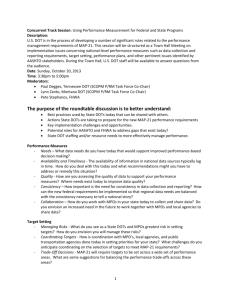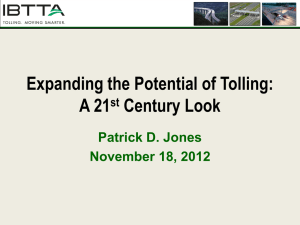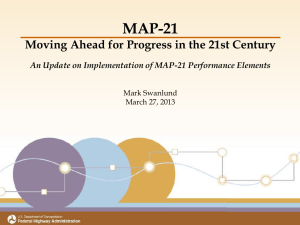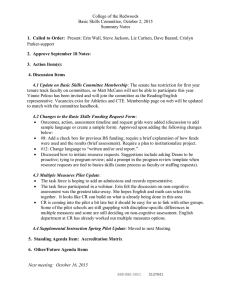New Jersey Pilot Study NATMEC 2014 Testing Potential MAP-21 System Performance Measures
advertisement
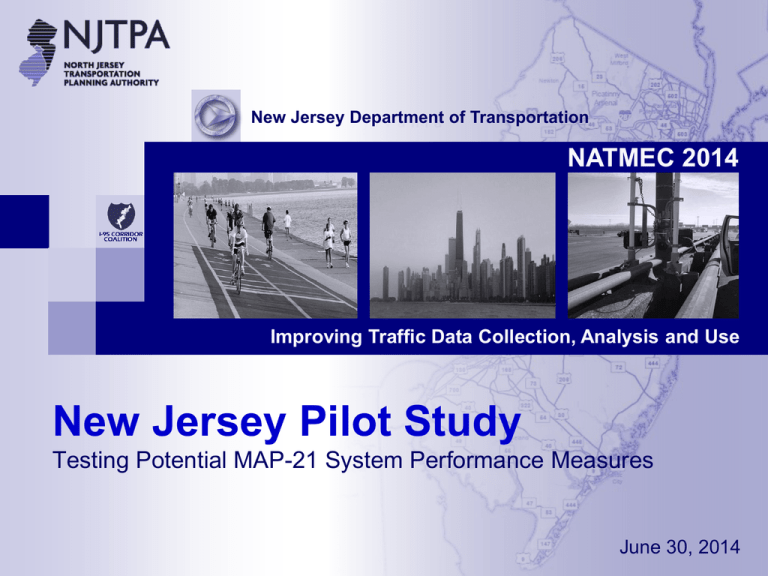
NATMEC 2014 New Jersey Department of Transportation NATMEC 2014 Improving Traffic Data Collection, Analysis and Use New Jersey Pilot Study Testing Potential MAP-21 System Performance Measures June 30, 2014 NATMEC 2014 What We’ll Cover Today Project Approach Pilot Corridors Data Sources Performance Measure Calculations Variations Annual Hours of Delay Reliability Indexes Thresholds Measurement Unit Aggregation Results Wrap-up Issues & Challenges Other Considerations Possible Next Steps/Recommendations June 30, 2014 NJ Pilot Study Testing Potential MAP-21 System Performance Measures 2 NATMEC 2014 Project Approach Test system-level performance measure methodologies For two NJ corridors (Interstate, arterial) Test AASHTO recommended measures for delay and reliability Propose/test alternate formulations Test alternate thresholds Evaluate aggregation methods Assess results – what the values are telling us Note barriers, challenges, assumptions, workarounds Develop a Summary Report Outline step-by-step procedures Present results, “lessons learned” Provide recommendations June 30, 2014 NJ Pilot Study Testing Potential MAP-21 System Performance Measures 3 NATMEC 2014 Pilot Corridors Chosen based on regional importance, unique features and familiarity Interstate; rural to urban; portion with local & express lanes; toll & free 78-C 78-B 78-A 78-D • Entire length – 67.8 miles • Divided into 4 sub-corridors: - PA border to I-287 (30.8 miles) - I-287 to GSP (22.6 miles) - GSP to NJ Tpk (5.4 miles) - NJ Tpk to Holland Tunnel (9.0 miles) 18-D NHS freeway & arterial; limited access & traffic signals; urban, commercial, semi-rural 18-C • Entire length – 45.3 miles • Divided into 4 sub-corridors: 18 -B 18-A June 30, 2014 - NJ 138 to GSP (14.3 miles) - GSP to US 9 (16.1 miles) - US 9 to NJTPK (9.5 miles) - NJTPK to Hoes Lane (5.4 miles) NJ Pilot Study Testing Potential MAP-21 System Performance Measures 4 NATMEC 2014 Data Sources Travel Time (Speed) Data Vehicle Probe Project (VPP) Suite (Massive Raw Data Downloader) Five-minute average -- reliability Hourly average -- delay Vehicle Probe Project Suite Vehicle/Truck/Bus NJDOT Congestion Management System (NJCMS) NJ TRANSIT General Transit Feed Specifications (GTFS) NJDOT Weigh-in-motion (WIM) Vehicle Occupancy Plan4Safety (Crash database) NJ TRANSIT (Bus load factors) June 30, 2014 NJ Pilot Study Testing Potential MAP-21 System Performance Measures 5 NATMEC 2014 Performance Measure Calculations Annual Hours of Delay (AHD) & Reliability June 30, 2014 NJ Pilot Study Testing Potential MAP-21 System Performance Measures 6 NATMEC 2014 Annual Hours of Delay (AHD) Compare hourly travel times with threshold travel time Consider options for “Agency-specified” thresholds Delay Time = Travel Time in excess of threshold Delay = Delay Time x Volume (vehicles/persons/trucks/buses) AASHTO Method Hourly travel times for an “Average Week” Calculate delay for an average week, multiply by 52 TMC delays can be aggregated to sub-corridors and corridors by adding Alternate Method Concern: “Average Week” data underestimates annual delay If particular Avg TT < Threshold TT, Delay Time = 0 But individual day TT for that time of day, day of week Proposal: Use hourly data for each day of the year June 30, 2014 NJ Pilot Study Testing Potential MAP-21 System Performance Measures 7 NATMEC 2014 Reliability AASHTO Reliability Index (RI80) RI80 = Maximum TT80/Threshold TT In words: TT multiplier to ensure on-time arrival 80% of the time if you happen to be traveling in the most congested 5-minute period, compared to a threshold TT for that segment, regardless of time of day Alternate Method (TTRMax) Concerns: RI80 threshold TT does not reflect congested conditions; most unreliable time of day may not be most congested time of day; extreme values for RI80 (>7, <1) Proposal: TTRMax = max (TT80/TT50) In words: TT multiplier to ensure on-time arrival 80% of the time, if you happen to be traveling in the most unreliable 5-minute period of the day, compared to a median travel time for that segment for that five-minute period Denominator doesn’t have to be median, but should vary with time (otherwise is the same as RI80) This method give less extreme values June 30, 2014 NJ Pilot Study Testing Potential MAP-21 System Performance Measures 8 NATMEC 2014 Comparative Example – RI80 vs. TTRMax TMC 120P04419 4.5 Travel Time, minutes 4 TT80 TT50 3.5 3 Max TT80 = 4.19 min (7:50 AM) Free-flow TT = 0.56 min Annual Median TT = 0.59 min RI80 = 7.1 or 7.5 2.5 2 Max TT50 = 1.73 min (7:55 AM) 1.5 1 0.5 0 2:00 AM 4:00 AM 6:00 AM 8:00 AM 4:00 PM 6:00 PM 8:00 PM 10:00 PM 12:00 AM TTRMax = 4.8 (8:55 AM) TT80 = 3.32 min TT50 = 0.69 min 6 TTR TTR = TT80/TT50 10:00 AM 12:00 PM 2:00 PM Time of Day 5 4 Maximum unreliability is not at the same time as maximum 80th percentile travel time 3 2 1 0 12:00 AM 2:00 AM June 30, 2014 4:00 AM 6:00 AM 8:00 AM 10:00 AM 12:00 PM 2:00 PM Time of Day 4:00 PM 6:00 PM NJ Pilot Study Testing Potential MAP-21 System Performance Measures 8:00 PM 10:00 PM 12:00 AM 9 NATMEC 2014 Variations Thresholds Measurement Unit Aggregation June 30, 2014 NJ Pilot Study Testing Potential MAP-21 System Performance Measures 10 NATMEC 2014 Threshold Variations Free-flow travel time Use calculated 15th percentile travel time (using 5-minute data) Same as travel time at 85th percentile speed Implies that freely flowing roadways are “goal” Median travel time over all days Single value, but similar to free-flow travel time, unless always congested Median travel time by day of week and hour of day Reflective of “expected” conditions by time of day & day of week May be more appropriate for reliability threshold than delay threshold Maximum throughput travel time (at 85% of the posted speed) Based on Washington State DOT practice “Acceptable” travel time Percentage of free-flow travel time that varies based on area type and time of day Context-sensitive Area Type Urban Suburban Rural Percent of Free-flow Travel Time Peak Off-peak 167% 133% 133% 118% 111% 105% All thresholds capped at speed limit June 30, 2014 NJ Pilot Study Testing Potential MAP-21 System Performance Measures 11 NATMEC 2014 Threshold Comparison For Average Week Example Link A "Acceptable" TT (TMC 120+04411) Maximum Throughput TT 3 Median TT, all days 2.8 Freeflow TT Median TT, day/hr Travel time, min 2.6 Average TT 2.4 2.2 2 1.8 1.6 1.4 Sun 12 AM Mon 12 AM Tue 12 AM Wed 12 AM Thu 12 AM Fri 12 AM Sat 12 AM Sun 12 AM Day of week and hour of day June 30, 2014 NJ Pilot Study Testing Potential MAP-21 System Performance Measures 12 NATMEC 2014 Measurement Unit Variations Vehicles (vehicle-hours, vehicle-miles) Person (person-hours, person-miles) Measures the total people moved Auto passengers Bus passengers Buses Measures only the number of vehicles moved Where PMs impact buses Trucks Sub corridor 2008-2010 Vehicles 2008-2010 Occupants AVO 78A 4,202 5,958 1.42 78B 4,987 6,542 1.31 78C 3,075 4,248 1.38 78D 2,280 3,198 1.40 18A 781 990 1.27 18B 755 965 1.28 18C 3,424 4,673 1.36 18D 1,546 2,015 1.30 Where PMs impact trucks June 30, 2014 NJ Pilot Study Testing Potential MAP-21 System Performance Measures 13 NATMEC 2014 Aggregation Variations TMC Corridor Delay (Units of Hours) Sub-Corridor Simple addition Reliability (Indices) Reliability measures are “unit-less”, cannot be added together Option 1: Weighted Averages Many possibilities for TMC weights: Link length Daily vehicle miles traveled (VMT) Median travel time Daily person miles traveled (PMT) Daily vehicle volume Daily vehicle hours traveled (VHT) Daily person volume Daily person hours traveled (PHT) Option 2: Calculate reliability directly at sub-corridor/corridor level (by direction) Add up travel times for entire sub-corridor/corridor Calculate statistics and index values similar to TMC level June 30, 2014 NJ Pilot Study Testing Potential MAP-21 System Performance Measures 14 NATMEC 2014 Results Corridor/Sub-Corridor for AHD and Reliability June 30, 2014 NJ Pilot Study Testing Potential MAP-21 System Performance Measures 15 NATMEC 2014 AHD Results Example: I78 (TMC-level) Shown in Person-Hours of Delay/mile ¯ Free-flow Threshold Hourly Person Volume x Travel Time above threshold Person Volume = Vehicle Volume x AVOSubcorr + Bus Passengers Over all days N 78-C 78-D Legend APHD/mile (Freeflow Threshold) 47 - 25,000 Varying Threshold Travel Time Creates Different AHD Results Free-flow travel time Maximum “thru-put” travel time (85% of posted speed) Additional thresholds not shown Yearly median Day/Hour median “Acceptable” travel time 0 0.75 1.5 3 Miles 25,000 - 50,000 50,000 - 100,000 100,000 - 654,000 ¯ Max. Thru-put Threshold N 78-C 78-D Legend APHD/mile (Max Thruput) 0 - 25,000 0 0.75 1.5 3 Miles 25,000 - 50,000 50,000 - 100,000 100,000 - 1,430,000 June 30, 2014 NJ Pilot Study Testing Potential MAP-21 System Performance Measures 16 NATMEC 2014 AHD Threshold Variation Results Varying threshold travel time results in different outcomes No consistent pattern Each threshold option has unique policy implications for “delay” Annual Person-Hours of Delay per mile (thousands) 140 120 100 80 60 40 20 0 18 Corridor Free-flow June 30, 2014 18A 18B Yearly Median 18C 18D 78 Corridor Max Throughput 78A 78B “Acceptable” Speed NJ Pilot Study Testing Potential MAP-21 System Performance Measures 78C 78D Day/Hr Median 17 NATMEC 2014 RI80 Threshold Variation Results Varying Threshold Travel Time Creates Different RI80 Results Free-flow travel time Yearly Median travel time Maximum Throughput travel time (85% of posted speed) Extreme values Values under 1.0 Worst 80th percentile TT < threshold TT Not a logical multiplier Set to 1.0 Legend 1.00 1.01 - 1.20 1.21 - 1.50 1.51 - 2.00 2.01 < Values above 7.0 June 30, 2014 Worst 80th percentile TT > seven times threshold TT! NJ Pilot Study Testing Potential MAP-21 System Performance Measures 18 NATMEC 2014 Alternate Formulation (RI80 vs. TTRMax) TTRMax gives more moderate (realistic?) values than RI80 on a TMC basis… AASHTO Formula Alternate Formula June 30, 2014 NJ Pilot Study Testing Potential MAP-21 System Performance Measures 19 NATMEC 2014 Alternate Formulation (RI80 vs. TTRMax) Reliability Alternatives Median Threshold - Aggregated with PHT Weights 2.8 …but differences are less pronounced on a corridor or subcorridor level 2.6 2.4 2.2 2.0 1.8 1.6 1.4 1.2 1.0 RI80 June 30, 2014 TTRMax NJ Pilot Study Testing Potential MAP-21 System Performance Measures 20 NATMEC 2014 Wrap-up Issues & Challenges Other Considerations Possible Next Steps/Recommendations June 30, 2014 NJ Pilot Study Testing Potential MAP-21 System Performance Measures 21 NATMEC 2014 Issues & Challenges – General MS Access has 2 GB file size limitation Use multiple databases with linked tables Alternatively, use an enterprise DBMS (e.g., SQL, Oracle) or statistics package (e.g., SPSS, SAS) Manual conflation of TMCs (for volumes) tedious and timeconsuming NJCMS missing hourly volumes by day of week, especially weekends Hopefully a one-time process Currently assuming average weekday hourly volumes apply to all 7 days Determining how to “aggregate up” TMCs for “telling the story”, particularly for reliability June 30, 2014 NJ Pilot Study Testing Potential MAP-21 System Performance Measures 22 NATMEC 2014 Issues & Challenges – NJ Specific Lacking traffic volume data in NJCMS for 128 miles of the enhanced NHS (need to find out coverage of INRIX and NPMRDS/here data) Accounting for transit ridership is problematic: Tedious process to use GTFS tables to get number of NJ TRANSIT buses on each TMC during each hour for weekday and weekends Applying typical peak/off-peak loading factors to get number of passengers Missing private and university bus data NJDOT Specific IT/OIT (Hardware/Software/Bandwidth) – significant tech issues Staff Knowledge/Skill Sets – rapidly evolving tech/data difficult to keep up with; using AOD creatively to “tell the story” challenging for most Time – current workload/staffing makes taking on new, complex work difficult; department-wide attrition also a factor June 30, 2014 NJ Pilot Study Testing Potential MAP-21 System Performance Measures 23 NATMEC 2014 Other Considerations Why PM changes occur (may be difficult to quantify and could affect target-setting) Complex issues re signalized arterials Signal spacing/side friction Multiple speed curves Algorithms are evolving (makes trending tricky) Functional class More critical thinking needed re: “agency-determined threshold travel times” Project effectiveness? Change in background traffic growth? Economy boom or bust? Gas prices? Across performance measures Across agencies Analytical tools HIGHLY DESIRABLE Automates the process Minimizes errors Speeds production Creates consistent summary output (tables, graphs, visualizations) June 30, 2014 NJ Pilot Study Testing Potential MAP-21 System Performance Measures 24 NATMEC 2014 Possible Next Steps/Recommendations Look at multiple years to see what changes in PMs occur Temporally Spatially Test corridors/years where there have been recently completed projects Have other States and MPOs run through similar tests “Telling the story” about project effectiveness Varying levels of resources, tools, expertise, etc. Test the PM methodologies using NPMRDS datasets Data completeness, integrity, etc. June 30, 2014 NJ Pilot Study Testing Potential MAP-21 System Performance Measures 25 NATMEC 2014 Thank you! Questions Comments Discussion Keith Miller, Principal Planner Data Analysis & Forecasting kmiller@njtpa.org June 30, 2014 John C. Allen, Section Chief Bureau of Commuter,/Mobility Strategies john.allen@dot.state.nj.us NJ Pilot Study Testing Potential MAP-21 System Performance Measures 26
